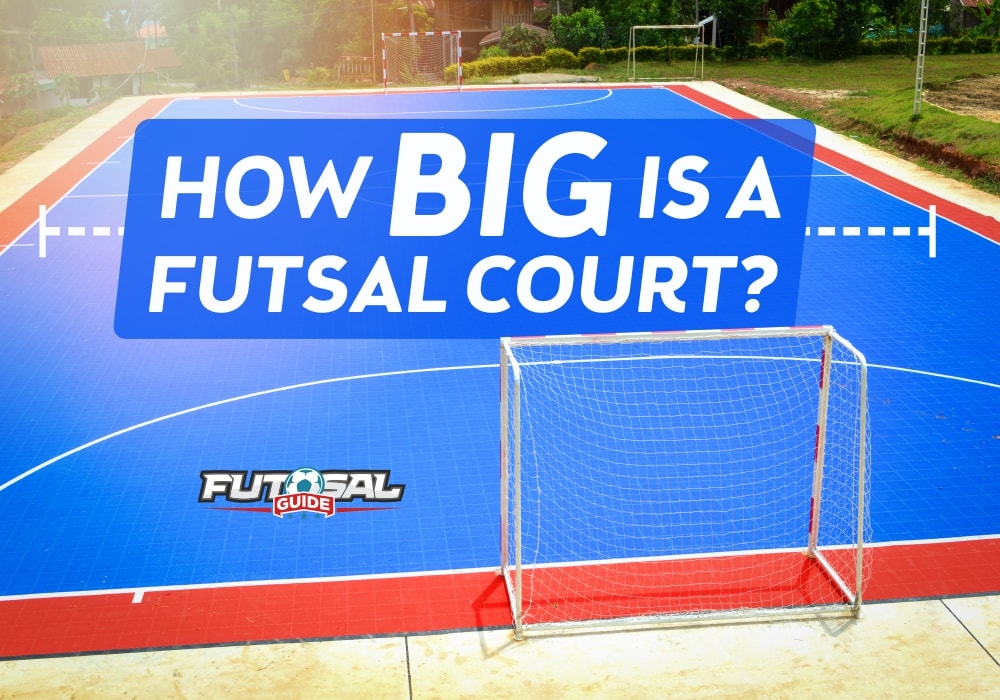Like me, you’ve probably played plenty of games of futsal without ever knowing exactly how big the court is other than it reminding you of a basketball court.I’ve got all the information so you know about how far your next worldie goal is struck from.
Well, How Big Is A Futsal Court? According to the FIFA Futsal Laws of the game the futsal court sizes are:
International Matches:
Length of the Futsal court is between 38–42 m (125–138 ft)
Width of the Futsal court is between 20–25 m (66–82 ft)
All other matches:
Length of the Futsal court is between 25–42 m (82–138 ft)
Width of the Futsal court is between 16–25 m (52–82 ft)
There must be a height of at least 4 meters (13ft) to the ceiling, applicable to all courts.
Depending on where you play and what your local governing body dictates you may play on a slightly deviated court size from that also.
There is also another governing body of Futsal named the Association Mundial De Football (AMF), when you consider all these factors there is definitely more information to digest.
Court sizes can change the way players and teams approach each game from tactics to what players to bring along to game day.
With so many dynamics at play, it’s integral that any prospective or current players completely understand not only the length and width of the court but the inner dimensions also and how they affect the game.
Court Boundaries And Key Markings
Futsal courts have to be rectangular if they aren’t it’s probably not an official Futsal match and is perhaps being played under “house rules” or something similar. All boundary markings must be eight centimeters in length.
As well as being rectangular the court should have a central point marked which represents the exact halfway point of the court. The central point will be used for kick off or to restart play after a goal has been scored by either side. The central point will be surrounded by a circle three meters in radius.
To ensure that players do not infringe on corner kick takers a mark has to be made on the outside of the court five meters in distance to the corner arc with a right angle towards the goal. This will assist players and referees to ensure that a violation does not occur. This mark should officially be eight centimeters in length.
In addition to the corner marking, additional lines also need to be marked either side if the second penalty spot five meters apart, these markings should be eight centers in length too. These markings represent the minimum space that must be maintained when a spot-kick is taking place from the second penalty spot.
The Goalkeeper’s D
The penalty box or the goalkeepers D is approximately six meters in diameter measured from the goal line. Inside the goalkeepers, D goalkeepers are able to handle the ball with their hands to disperse balls, block shots and receive passes.
When a goalkeeper exits the D they are treated as an outfield player and lose all special privileges afforded to them. Some indoor soccer rules do not allow players to enter the goalkeepers D to score goals or receive the ball; this is not the case in Futsal as any player can enter the D to win the ball.
Penalty Spots
For fouls committed on opposition players by the goalkeeper or other outfield players then a penalty will be awarded at the center of the goalkeeper’s D approximately 6 meters from the goal, dead center.
There is also a second penalty spot in Futsal, the second penalty spot is 10 meters from the goal line, again dead center.When more than 5 “direct” fouls are committed then every foul after the fifth will result in a 10-metre penalty kick.
Corners
Corners will have a twenty-five centimeter quarter circle for which to return the ball to open play.
Goals
Goals are to be set at the central point of the goal lines, goals have an area of six square meters.The goal will be of three meters wide by two meters high.
The goal frame must be eight centimeters in depth and length, and they must also be sturdy with a counterweight or fixed so that they cannot overturn and cause injury to players or spectators.
Substitutes areas
The old dugout, well I guess we can’t really call it that as it’s indoors. The subs bench is probably more appropriate. Situated either side of the timekeepers table by five metres, which itself is central to the futsal court.
The substitute zones are marked eighty centimeters in length with half on the pitch and half off the pitch. This is the area that players will use to interchange with teammates in their defensive halves.
Pro tip: Do not swap with your teammate outside of this zone, you will incur a costly foul for your team if it is spotted by match officials.
Related Questions
Is A Futsal Court The Same Size As Basketball Court? Futsal courts are not the same size as a basketball court. I have played many futsal games when I first started that were held on basketball courts, these competitions were also regulated by the FIFA body where I lived – quite surprising I know but I think it was mainly due to lack of appropriate facilities.
An NBA basketball official court is 28.7 meters (94 ft) by 15.2 meters (50ft) which is well short of an official Futsal Court.
Is The AMF Futsal Court Sizes The Same As The Fifa Futsal Court? The Futsal court size requirements from AMF are slightly different to FIFA, they are:
International Matches
Length of the Futsal court is between 36–40 m (118–131 ft)
Width of the Futsal court is between 18–20 m (59–65 ft)
All other matches:
Length of the Futsal court is between 28–32 m (91–104 ft)
Width of the Futsal court is between 16–20 m (52–65 ft)
Not much of a difference between the two, very slight across the board.


 futsalguide.com
futsalguide.com



 futsalguide.com
futsalguide.com 
 futsalguide.com
futsalguide.com